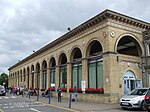Mill Road, Cambridge

Mill Road is a street in southeast Cambridge, England. It runs southeast from near to Parker's Piece, at the junction with Gonville Place, East Road, and Parkside. It crosses the main railway line and links to the city's ring road (the A1134). It passes through the wards of Petersfield and Romsey, which are divided by the railway line. It is a busy street containing many independent businesses, churches, a Hindu temple and Cambridge Central Mosque. Near the northwestern end to the south in Mortimer Road off Mill Road is Hughes Hall. Behind Hughes Hall is Fenner's, the cricket ground of the University of Cambridge, which has hosted first-class cricket since 1848. To the north is Anglia Ruskin University, formerly Cambridgeshire College of Arts and Technology (CCAT).
Excerpt from the Wikipedia article Mill Road, Cambridge (License: CC BY-SA 3.0, Authors, Images).Mill Road, Cambridge
Mill Road, Cambridge Petersfield
Geographical coordinates (GPS) Address Phone number Nearby Places Show on map
Geographical coordinates (GPS)
| Latitude | Longitude |
|---|---|
| N 52.1999 ° | E 0.1376 ° |
Address
Pizza Hut Delivery
Mill Road 83
CB1 2AW Cambridge, Petersfield
England, United Kingdom
Open on Google Maps








